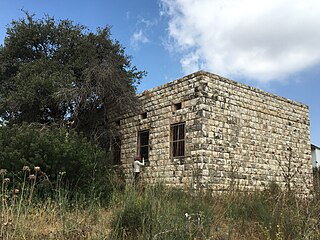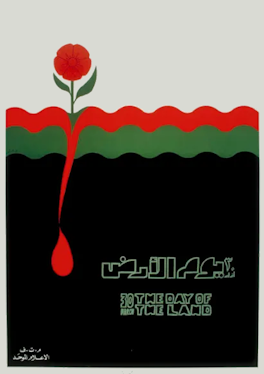
Nazareth is the largest city in the Northern District of Israel. In 2022 its population was 78,007. Known as "the Arab capital of Israel", Nazareth serves as a cultural, political, religious, economic and commercial center for the Arab citizens of Israel, as well as a center of Arab and Palestinian nationalism. The inhabitants are predominantly Arab citizens of Israel, of whom 69% are Muslim and 30.9% Christian. The city also commands immense religious significance, deriving from its status as the hometown of Jesus, the central figure of Christianity and a prophet in Islam.

Jenin is a city in the State of Palestine, in the Israeli-occupied West Bank. The city serves as the administrative center of the Jenin Governorate of Palestine and is a major center for the surrounding towns. Jenin came under Israeli occupation in 1967, and was put under the administration of the Palestinian National Authority as Area A of the West Bank in 1993.

Achziv or Az-Zeeb is an ancient site on the Mediterranean coast of northern Israel, between the border with Lebanon and the city of Acre. It is located 13.5 kilometres (8.4 mi) north of Acre on the coast of the Mediterranean Sea, within the municipal area of Nahariya. Today it is an Israeli national park.

Amka, also known in Arabic as Amqa, is a moshav in the Matte Asher Regional Council of Israel's Northern District, near Acre. The location of the moshav roughly corresponds the former Palestinian village, depopulated during the 1948 Arab–Israeli War. Yemenite Jews founded the village's successor Amka in 1949. In 2022 its population was 833.

Al-Birwa was a Palestinian Arab village, located 10.5 kilometers (6.5 mi) east of Acre (Akka). In 1945, it had a population of 1,460, of whom the majority were Muslims and a significant minority, Christians. Its total land area consisted of 13,542 dunams. The village was depopulated during the 1948 Arab–Israeli War.

Al-Kabri was a Palestinian Arab town in the Galilee located 12.5 kilometers (7.8 mi) northeast of Acre. It was captured by the Haganah 21 May 1948, a week after the State of Israel was declared. In 1945, it had a population of 1,530 and a total area cultivated of 20,617 dunams. It is near the site of Tel Kabri.

Umm al-Faraj, was a Palestinian village, depopulated in 1948.

Nahariya is the northernmost coastal city in Israel. As of 2022, the city had a population of 63,947.

Safed is a city in the Northern District of Israel. Located at an elevation of up to 937 m (3,074 ft), Safed is the highest city in the Galilee and in Israel. It is known as the "capital" of the Galilee.

Sepphoris, known in Hebrew as Tzipori and in Arabic as Saffuriya is an archaeological site located in the central Galilee region of Israel, 6 kilometres (3.7 mi) north-northwest of Nazareth. It lies 286 meters (938 ft) above sea level and overlooks the Beit Netofa Valley. The site holds a rich and diverse historical and architectural legacy that includes Hellenistic, ancient Jewish, Roman, Byzantine, early Islamic, Crusader, Mamluk and Ottoman remains. In the Roman period, it was also called Diocaesaraea. In Mandatory Palestine, Saffuriya was a Palestinian Arab town with a population of approximately 5000 people at the time of its depopulation in 1948.
Kabri is a kibbutz in northern Israel. Located in the Western Galilee about 4 kilometres (2 mi) east of the Mediterranean seaside town of Nahariya, it falls under the jurisdiction of Mateh Asher Regional Council. In 2022 it had a population of 1,120.

Land Day, recurring on March 30, is a day of commemoration for Palestinians, both Arab citizens of Israel and those in the Israeli-occupied territories of the events of that date in 1976 in Israel.
Gesher HaZiv is a kibbutz in northern Israel. Situated in the Western Galilee on the coastal highway between Nahariya and the Lebanese border, opposite the Akhziv National Park, it falls under the jurisdiction of Mateh Asher Regional Council. In 2022 it had a population of 1,631.
How To Start Your Own Country is a British six-part documentary comedy series aired between August and September 2005. The show was presented by British comedian Danny Wallace and followed his quest to start his own country in his flat in Bow, London. The micronation he created was eventually named "Kingdom of Lovely".
The Kingdom of Vikesland was a micronation in Manitoba, Canada. It was founded in 2005 by Christopher Barry Joseph Beyette, a television news cameraman employed by the CHUM network.

Micronations: The Lonely Planet Guide to Home-Made Nations is an Australian gazetteer about micronations, published in September 2006 by Lonely Planet. It was written by John Ryan, George Dunford and Simon Sellars. Self-described as a humorous guidebook and written in a light-hearted tone, the book's profile of micronations offers information on their flags, leaders, currencies, maps and other facts. It was re-subtitled Guide to Self-Proclaimed Nations in later publications.
Iranian Jews in Israel refers to the community of Iranian Jews who immigrated to Ottoman Palestine, Mandatory Palestine, and later the State of Israel. Iranian Jews in Israel number over 135,000 and most of them are Israeli born.

The 1974 Nahariya attack was a raid by three Palestinian terrorists, belonging to the Fatah militant organization, which took place during the night between 24 and 25 June 1974. The Palestinian terrorist squad infiltrated the coastal city of Nahariya in Israel by sea from Lebanon. Three civilians and one Israeli soldier were killed during the event. The attack was the first time in which terrorists infiltrated into Israel from Lebanon by sea.















